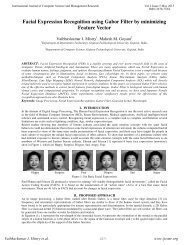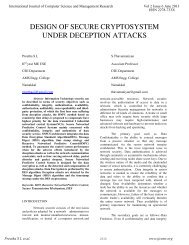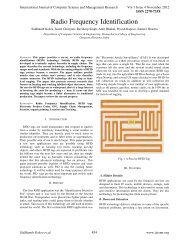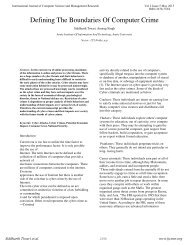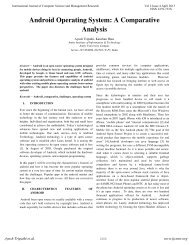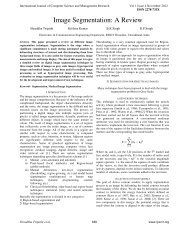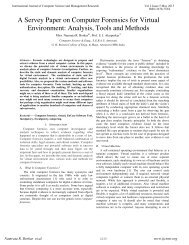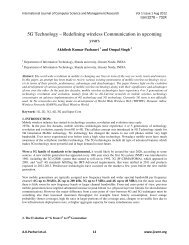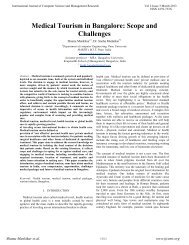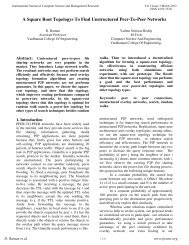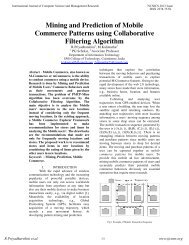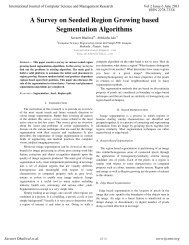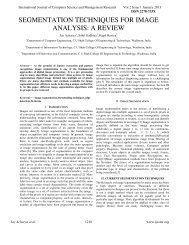Trust Based Resource Allocation Technique for Anonymous ... - ijcsmr
Trust Based Resource Allocation Technique for Anonymous ... - ijcsmr
Trust Based Resource Allocation Technique for Anonymous ... - ijcsmr
You also want an ePaper? Increase the reach of your titles
YUMPU automatically turns print PDFs into web optimized ePapers that Google loves.
International Journal of Computer Science and Management Research Vol 2 Issue 2 February 2013<br />
ISSN 2278-733X<br />
trustworthiness suitable <strong>for</strong> applications in an ad-hoc<br />
network. <strong>Trust</strong> model in an adaptation of Marsh’s [5]<br />
trust model, but they merged utility and importance in<br />
one variable called weight <strong>for</strong> simplicity. They<br />
categorized trust into different categories and calculated<br />
trust as a sum of all these weighted categories. <strong>Based</strong> on<br />
the protocol and on the scenario to which the trust model<br />
is applied, the total number of categorized with trust was<br />
defined. The main goal of their model was to build route<br />
trustworthiness in nodes by extending the dynamic<br />
source protocol to receive a complete list of all nodes<br />
through which a protocol has passed.<br />
R.Gunasekaran [6] proposed the high-privileged<br />
and low-privileged architecture (HPLP) <strong>for</strong> Ad Hoc<br />
network <strong>for</strong> achieving optimal differentiated services <strong>for</strong><br />
different classes of users. The new protocol, DMACAW,<br />
was implemented. Among the various factors influencing<br />
the differentiated services, bandwidth reservation is only<br />
considered and different factors that can influence the<br />
efficiency of the bandwidth reservation are identified.<br />
The drawback of this proposed approach is that the<br />
complexity issues such as processing time, transaction<br />
time (latency), buffer management and memory<br />
utilization is not considered.<br />
A number of anonymous routing schemes have<br />
been proposed <strong>for</strong> ad hoc networks in recent years, and<br />
they provide different level of privacy protection at<br />
different cost. Most of them rely on public key<br />
cryptosystems (PKC) to achieve anonymity and<br />
unlinkability in routing.<br />
ASR [7], ARM [8], AnonDSR [9] and ARMR<br />
[10], also make use of one-time public/private key pairs<br />
to achieve anonymity and unlinkability. ASR is designed<br />
to achieve stronger location privacy than ANODR [11],<br />
which ensures nodes on route have no in<strong>for</strong>mation on<br />
their distance to the source/destination node. As the<br />
routing onion used in ANODR exposes distance<br />
in<strong>for</strong>mation to intermediate nodes. ARM considered to<br />
reduce computation burden on one-time public/private<br />
key pair generation. Different from the above schemes,<br />
ARMR uses one-time public keys and bloom filter to<br />
establish multiple routes <strong>for</strong> MANETs. An SDAR and<br />
ODAR [12] use long-term public/private key pairs at<br />
each node <strong>for</strong> anonymous communication. These<br />
schemes are more scalable to network size, but require<br />
more computation ef<strong>for</strong>t. For example, SDAR is similar<br />
to ARM except ARM uses shared secrets between source<br />
and destination <strong>for</strong> verification. Un<strong>for</strong>tunately, ODAR<br />
provides only identity anonymity but not unlinkability <strong>for</strong><br />
MANET, since the entire RREQ/RREP packets are not<br />
protected with session keys. An ALARM [13] makes use<br />
of group signature to preserve privacy. The group<br />
signature has a good privacy preserving feature in that<br />
everyone can verify a group signature but cannot identify<br />
who is the signer. But ALARM still leaks lot sensitive<br />
privacy in<strong>for</strong>mation: network topology, location of every<br />
node.<br />
3. Proposed work<br />
3.1. <strong>Trust</strong> management system<br />
In this approach, the trust level in a node is<br />
defined as a cumulative value that is based on the past<br />
behavior of the node. The trust level of a node increases<br />
as long as the node behaves exactly as it is supposed to<br />
(in our cases, follow reliably the steps of the routing<br />
protocol) or decreases as the node misbehaves<br />
accordingly. A node’s trust is computed by each of its<br />
direct neighboring nodes based on their past experience<br />
or observation of the node’s behavior. These neighboring<br />
nodes, together with the evaluated node, <strong>for</strong>m what we<br />
refer to as a community.<br />
Community and Community Key Management<br />
In our system, a node’s community is as the set<br />
of nodes that includes the node itself, referred as central<br />
node, and all of its one-hop neighboring nodes, among<br />
which some may be malicious. In this approach, a node<br />
keeps track of its neighbors simply by listening <strong>for</strong> a<br />
HELLO message, which is broadcasting periodically by<br />
each node. In each community, the central node classifies<br />
its neighboring nodes into three classes, based on their<br />
trust level. The first and lowest trust level is <strong>for</strong> nodes<br />
whose trust value is between 0 and 1, while the second<br />
trust level, i.e. the medium level, contains the nodes<br />
whose trust level is between 1 and 2. The trust level,<br />
corresponding to the high level, contains the nodes whose<br />
trust value is between 2 and ∞.<br />
The central node generates two different keys<br />
<strong>for</strong> the medium and high trust level, and shares them with<br />
its neighbors. All neighbors in the same trust level share<br />
the same key. The neighbors in high trust level will have<br />
both High <strong>Trust</strong> Level Community Key (HTLCK) and<br />
Medium <strong>Trust</strong> Level Community Key (MTLCK),<br />
whereas, the neighbors in medium trust level have only<br />
MTLCK. As <strong>for</strong> the neighbors in low trust level, they do<br />
not share any community key at all. When the central<br />
node detects a new neighbor, it will assign an initial trust<br />
value to it and updates this trust level later on, based on<br />
their interaction.<br />
<strong>Trust</strong>worthy intermediate node selection mechanism<br />
When a source node initiates the <strong>Trust</strong><br />
establishment process, it specifies the trust level<br />
requirement in the initial message. Each intermediate<br />
node will propagate the message only to selected<br />
neighboring nodes, depending on the source node<br />
requested trust level. If the requested trust level is high,<br />
the node will use the community key <strong>for</strong> the neighbors<br />
with high trust level to encrypt the message; this will<br />
ensure that only highly trusted nodes will participate in<br />
the node selection. If the required trust level is medium,<br />
the node will use the community key <strong>for</strong> the neighbors<br />
Raghu. R et.al.<br />
1535<br />
www.<strong>ijcsmr</strong>.org




